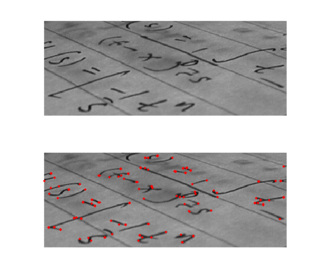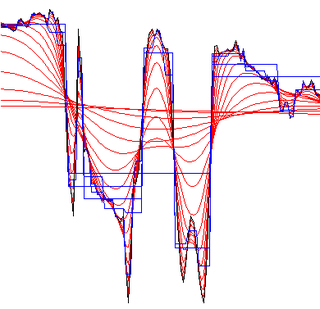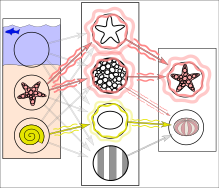Edge detection includes a variety of mathematical methods that aim at identifying edges, curves in a digital image at which the image brightness changes sharply or, more formally, has discontinuities. The same problem of finding discontinuities in one-dimensional signals is known as step detection and the problem of finding signal discontinuities over time is known as change detection. Edge detection is a fundamental tool in image processing, machine vision and computer vision, particularly in the areas of feature detection and feature extraction.

The Canny edge detector is an edge detection operator that uses a multi-stage algorithm to detect a wide range of edges in images. It was developed by John F. Canny in 1986. Canny also produced a computational theory of edge detection explaining why the technique works.
The scale-invariant feature transform (SIFT) is a computer vision algorithm to detect, describe, and match local features in images, invented by David Lowe in 1999. Applications include object recognition, robotic mapping and navigation, image stitching, 3D modeling, gesture recognition, video tracking, individual identification of wildlife and match moving.
Scale-space theory is a framework for multi-scale signal representation developed by the computer vision, image processing and signal processing communities with complementary motivations from physics and biological vision. It is a formal theory for handling image structures at different scales, by representing an image as a one-parameter family of smoothed images, the scale-space representation, parametrized by the size of the smoothing kernel used for suppressing fine-scale structures. The parameter in this family is referred to as the scale parameter, with the interpretation that image structures of spatial size smaller than about have largely been smoothed away in the scale-space level at scale .

Corner detection is an approach used within computer vision systems to extract certain kinds of features and infer the contents of an image. Corner detection is frequently used in motion detection, image registration, video tracking, image mosaicing, panorama stitching, 3D reconstruction and object recognition. Corner detection overlaps with the topic of interest point detection.

Scale-space segmentation or multi-scale segmentation is a general framework for signal and image segmentation, based on the computation of image descriptors at multiple scales of smoothing.
In image processing, ridge detection is the attempt, via software, to locate ridges in an image, defined as curves whose points are local maxima of the function, akin to geographical ridges.
In computer vision, blob detection methods are aimed at detecting regions in a digital image that differ in properties, such as brightness or color, compared to surrounding regions. Informally, a blob is a region of an image in which some properties are constant or approximately constant; all the points in a blob can be considered in some sense to be similar to each other. The most common method for blob detection is convolution.
Affine shape adaptation is a methodology for iteratively adapting the shape of the smoothing kernels in an affine group of smoothing kernels to the local image structure in neighbourhood region of a specific image point. Equivalently, affine shape adaptation can be accomplished by iteratively warping a local image patch with affine transformations while applying a rotationally symmetric filter to the warped image patches. Provided that this iterative process converges, the resulting fixed point will be affine invariant. In the area of computer vision, this idea has been used for defining affine invariant interest point operators as well as affine invariant texture analysis methods.
In mathematics, the structure tensor, also referred to as the second-moment matrix, is a matrix derived from the gradient of a function. It describes the distribution of the gradient in a specified neighborhood around a point and makes the information invariant respect the observing coordinates. The structure tensor is often used in image processing and computer vision.
In computer vision, speeded up robust features (SURF) is a patented local feature detector and descriptor. It can be used for tasks such as object recognition, image registration, classification, or 3D reconstruction. It is partly inspired by the scale-invariant feature transform (SIFT) descriptor. The standard version of SURF is several times faster than SIFT and claimed by its authors to be more robust against different image transformations than SIFT.
The Kadir–Brady saliency detector extracts features of objects in images that are distinct and representative. It was invented by Timor Kadir and J. Michael Brady in 2001 and an affine invariant version was introduced by Kadir and Brady in 2004 and a robust version was designed by Shao et al. in 2007.
The histogram of oriented gradients (HOG) is a feature descriptor used in computer vision and image processing for the purpose of object detection. The technique counts occurrences of gradient orientation in localized portions of an image. This method is similar to that of edge orientation histograms, scale-invariant feature transform descriptors, and shape contexts, but differs in that it is computed on a dense grid of uniformly spaced cells and uses overlapping local contrast normalization for improved accuracy.
In the fields of computer vision and image analysis, the Harris affine region detector belongs to the category of feature detection. Feature detection is a preprocessing step of several algorithms that rely on identifying characteristic points or interest points so to make correspondences between images, recognize textures, categorize objects or build panoramas.
The Hessian affine region detector is a feature detector used in the fields of computer vision and image analysis. Like other feature detectors, the Hessian affine detector is typically used as a preprocessing step to algorithms that rely on identifiable, characteristic interest points.
In computer vision, 3D object recognition involves recognizing and determining 3D information, such as the pose, volume, or shape, of user-chosen 3D objects in a photograph or range scan. Typically, an example of the object to be recognized is presented to a vision system in a controlled environment, and then for an arbitrary input such as a video stream, the system locates the previously presented object. This can be done either off-line, or in real-time. The algorithms for solving this problem are specialized for locating a single pre-identified object, and can be contrasted with algorithms which operate on general classes of objects, such as face recognition systems or 3D generic object recognition. Due to the low cost and ease of acquiring photographs, a significant amount of research has been devoted to 3D object recognition in photographs.
In computer vision, maximally stable extremal regions (MSER) are used as a method of blob detection in images. This technique was proposed by Matas et al. to find correspondences between image elements from two images with different viewpoints. This method of extracting a comprehensive number of corresponding image elements contributes to the wide-baseline matching, and it has led to better stereo matching and object recognition algorithms.
The principal curvature-based region detector, also called PCBR is a feature detector used in the fields of computer vision and image analysis. Specifically the PCBR detector is designed for object recognition applications.
Geometric feature learning is a technique combining machine learning and computer vision to solve visual tasks. The main goal of this method is to find a set of representative features of geometric form to represent an object by collecting geometric features from images and learning them using efficient machine learning methods. Humans solve visual tasks and can give fast response to the environment by extracting perceptual information from what they see. Researchers simulate humans' ability of recognizing objects to solve computer vision problems. For example, M. Mata et al.(2002) applied feature learning techniques to the mobile robot navigation tasks in order to avoid obstacles. They used genetic algorithms for learning features and recognizing objects (figures). Geometric feature learning methods can not only solve recognition problems but also predict subsequent actions by analyzing a set of sequential input sensory images, usually some extracting features of images. Through learning, some hypothesis of the next action are given and according to the probability of each hypothesis give a most probable action. This technique is widely used in the area of artificial intelligence.
Chessboards arise frequently in computer vision theory and practice because their highly structured geometry is well-suited for algorithmic detection and processing. The appearance of chessboards in computer vision can be divided into two main areas: camera calibration and feature extraction. This article provides a unified discussion of the role that chessboards play in the canonical methods from these two areas, including references to the seminal literature, examples, and pointers to software implementations.






